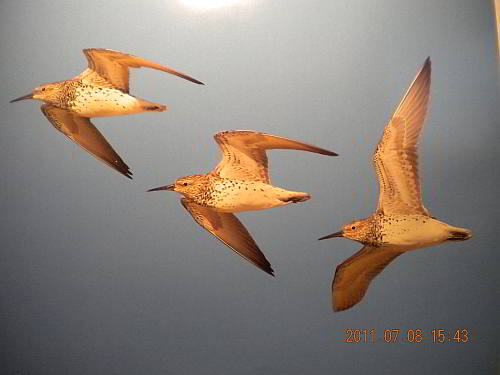World Migratory Birds Day: Olango Island vital stop of migratory birds

Great Knots conquer the sky of the Olango Island Wildlife Sanctuary. (Wild Bird Club of The Philipines)
Today, the world celebrates the importance of protecting migratory birds.
The World Migratory Bird Day (WMBD) is celebrated every second weekend of May. In line with this, the Department of Environment and Natural Resources (DENR) 7 urged the public to help protect migratory birds against trading and hunting.
Protection of these birds is needed most especially within the 1,028-hectare Olango Island Wildlife Sanctuary (OIWS) in Lapu-Lapu City, Cebu and other areas identified as migratory bird sanctuaries.
Bannered with the theme, “Destination flyways migratory birds and tourism,” the DENR-7 is observing the event with the objective of increasing the level of awareness on the importance of migratory birds in biodiversity.
“The OIWS is the Philippines’ first wetland of international importance for waterfowl as it supports the largest concentration of migratory birds found so far in the country,” said DENR-7 Regional Executive Director Isabelo Montejo.
He said there are about 97 species of birds in the OIWS, 48 of which are migratory species, while the rest are resident birds of the said island.
Among the recorded birds in the sanctuary are: Chinese Egret, Little Egret, Little Heron, Grey Plover, Kentish Plover, Greater Sand-Plover, Far Eastern Curlew, Eurasian Curlew, Whimbrel, Bar-tailed Godwit, Common Redshank, Common Greenshank, Common Sandpiper, Terek Sandpiper, Grey-tailed Tattler.
Other bird species recorded are: Ruddy Turnstone, Asian Dowitcher, Great Knot, Rufous-necked Stint, Curlew Sandpiper, Gull-billed Tern, Whiskered Tern, Common Kingfisher, White-collared Kingfisher, Barn Swallow, Pacific Swallow, Yellow-vented Bulbul, Golden-bellied Flyeater, Pied Fantail, Brown Shrike and Olive-backed Sunbird.
For today’s celebration, more than 70 participants including students, DENR personnel, members of people’s organizations, private individuals and other stakeholders will be visiting the OIWS.
There will be lectures on the importance of migratory birds as well as the history of migratory birds.
“Through this celebration, we in DENR-7 would want to highlight the need to protect and conserve all these migratory birds that visit our country every now and then. Communities should learn that birds play an integral part of the ecosystem and humans should help in protecting their existence,” Montejo said.
Other activities include field exercise on migratory bird identification, coastal cleanup, mangrove tour, and an on-the-spot painting to be participated in by the four volunteers.
The said paintings will then be donated to the OIWS and will be displayed inside its nature center.
From September to November, thousands of shorebirds migrate down south after breeding in China, Russia and Alaska. They go to Philippine bird sanctuaries like Olango Island and onto Australia and New Zealand farther down south following the East Asian-Australasian Flyway.
Soon after winter, from March to May, the shorebirds begin their northward migration and thousands of them pass by Olango en route to the breeding areas in the northern hemisphere.
The celebration, which was started in 2006, is an annual awareness-raising campaign highlighting the need for the protection of migratory birds and their habitats, Montejo said.
Disclaimer: The comments uploaded on this site do not necessarily represent or reflect the views of management and owner of Cebudailynews. We reserve the right to exclude comments that we deem to be inconsistent with our editorial standards.
